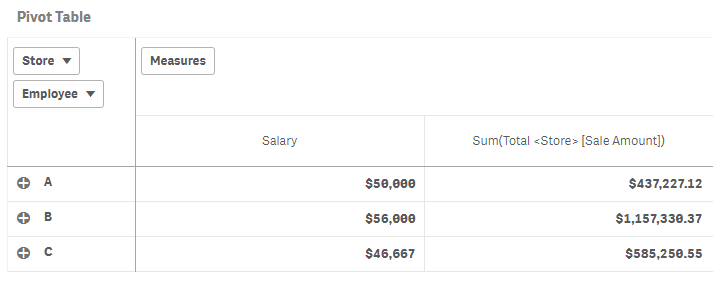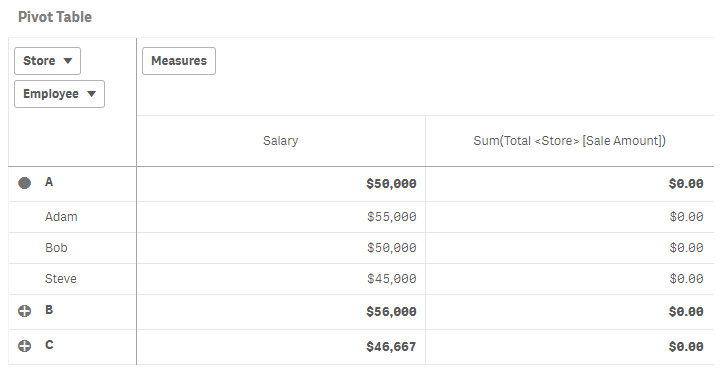Unlock a world of possibilities! Login now and discover the exclusive benefits awaiting you.
- Qlik Community
- :
- Forums
- :
- Analytics & AI
- :
- Products & Topics
- :
- App Development
- :
- Re: Using 'Total <Dimension>' in a Pivot Table in ...
- Subscribe to RSS Feed
- Mark Topic as New
- Mark Topic as Read
- Float this Topic for Current User
- Bookmark
- Subscribe
- Mute
- Printer Friendly Page
- Mark as New
- Bookmark
- Subscribe
- Mute
- Subscribe to RSS Feed
- Permalink
- Report Inappropriate Content
Using 'Total <Dimension>' in a Pivot Table in Qlik Sense
Hi,
I am trying to use the total keyword in a pivot table, and am getting strange results. I am using a fact table structure similar to the following:
| Store | Employee | Salary | Sale Amount |
| A | Bob | 50000 | |
| A | Adam | 55000 | |
| A | Steve | 45000 | |
| B | Geoff | 47000 | |
| B | Sandra | 70000 | |
| B | Charles | 56000 | |
| B | Felicity | 51000 | |
| C | Beth | 43000 | |
| C | Carter | 42000 | |
| C | Daniel | 39000 | |
| C | Susan | 53000 | |
| C | Pamela | 57000 | |
| C | Erin | 46000 | |
| A | 14963.95 | ||
| A | 31631.62 | ||
| A | 26528.53 | ||
| A | 12708.55 | ||
| A | 14206.99 | ||
| A | 95192.72 | ||
| A | 7123.50 |
.. and so on. The reason the Salaries are included in the fact table is that these values are attached to a particular payslip, and can change over time. The sales are not recorded against any particular employee, just against the store.
What I am trying to achieve is to display the sum of sales for that store, against each employee in a pivot table. The values are displayed correctly against the store, until a node is expanded, where each value is then turned to 0:


What I am trying to achieve is the Sum figure of $437,227.12 is displayed in this column for Adam, Bob and Steve.
Thanks.
- Tags:
- pivot total
- total
Accepted Solutions
- Mark as New
- Bookmark
- Subscribe
- Mute
- Subscribe to RSS Feed
- Permalink
- Report Inappropriate Content
- Mark as New
- Bookmark
- Subscribe
- Mute
- Subscribe to RSS Feed
- Permalink
- Report Inappropriate Content
Try this
Aggr(NODISTINCT Sum([Sale Amount]), Store)
- Mark as New
- Bookmark
- Subscribe
- Mute
- Subscribe to RSS Feed
- Permalink
- Report Inappropriate Content
Thanks Sunny!
That worked well. The only caveat is that if I enable Totals for the Stores, we do not get a value there:

Any thoughts on this?
- Mark as New
- Bookmark
- Subscribe
- Mute
- Subscribe to RSS Feed
- Permalink
- Report Inappropriate Content
May be this
If(Dimensionality() = 0, Sum(Aggr(Sum([Sale Amount]), Store)),
Aggr(NODISTINCT Sum([Sale Amount]), Store))
- Mark as New
- Bookmark
- Subscribe
- Mute
- Subscribe to RSS Feed
- Permalink
- Report Inappropriate Content
Thanks Sunny that works well.
- Mark as New
- Bookmark
- Subscribe
- Mute
- Subscribe to RSS Feed
- Permalink
- Report Inappropriate Content
Hello Sunny and Simonhoward . I am trying to accomplish the same thing. Sunny you said "The only caveat is that if I enable Totals for the Stores, we do not get a value there"? So how were you able to have the formula to work? Did you replace Stores with another field? Thanks